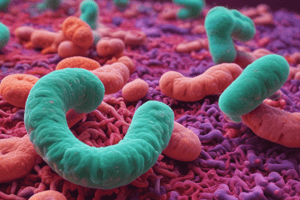Podcast
Questions and Answers
What is the distinguishing feature of Clostridium perfringens colonies on anaerobic blood agar?
What is the distinguishing feature of Clostridium perfringens colonies on anaerobic blood agar?
- Small, red colonies with no hemolysis
- Purple color
- Large, white colonies with double zone of hemolysis (correct)
- Yellow color
Which toxin prevents the release of acetylcholine, leading to flaccid paralysis and death?
Which toxin prevents the release of acetylcholine, leading to flaccid paralysis and death?
- Beta-toxin
- Enterotoxin
- Botulinum toxin (correct)
- Alpha-toxin
What is the morphology of Clostridium perfringens when gram stained?
What is the morphology of Clostridium perfringens when gram stained?
- Blue spirals
- Purple bacilli (correct)
- Red cocci
- Green rods
Which Clostridium perfringens-associated disease has a fatality rate of 15-25% if left untreated?
Which Clostridium perfringens-associated disease has a fatality rate of 15-25% if left untreated?
What is the incubation period for Enteritis necroticans caused by Clostridium perfringens?
What is the incubation period for Enteritis necroticans caused by Clostridium perfringens?
What symptom is often seen in patients with Enteritis necroticans?
What symptom is often seen in patients with Enteritis necroticans?
What is the mechanism of action of botulinum toxin on neurons?
What is the mechanism of action of botulinum toxin on neurons?
Which of the following best describes the clinical manifestations of myonecrosis caused by Clostridium perfringens?
Which of the following best describes the clinical manifestations of myonecrosis caused by Clostridium perfringens?
What is the most common clinical outcome when Clostridium perfringens overwhelms the normal flora in the gastrointestinal tract?
What is the most common clinical outcome when Clostridium perfringens overwhelms the normal flora in the gastrointestinal tract?
What is the effect of Clostridium perfringens exotoxin alpha-toxin on tissues?
What is the effect of Clostridium perfringens exotoxin alpha-toxin on tissues?
What phenomenon leads to flaccid paralysis and death due to Clostridium perfringens infection?
What phenomenon leads to flaccid paralysis and death due to Clostridium perfringens infection?
In which scenario does Clostridium perfringens cause disease in the gastrointestinal tract?
In which scenario does Clostridium perfringens cause disease in the gastrointestinal tract?
What is the main virulence factor produced by Clostridium perfringens?
What is the main virulence factor produced by Clostridium perfringens?
Which infection is caused by Clostridium perfringens and is characterized by ischemic necrosis of the jejunum?
Which infection is caused by Clostridium perfringens and is characterized by ischemic necrosis of the jejunum?
Which gas is a component of the gas mixture used for obligate anaerobes to grow?
Which gas is a component of the gas mixture used for obligate anaerobes to grow?
What is the spectrum of diseases associated with Clostridium perfringens?
What is the spectrum of diseases associated with Clostridium perfringens?
Which gas is NOT a component of the gas mixture used for obligate anaerobes to grow?
Which gas is NOT a component of the gas mixture used for obligate anaerobes to grow?
Which toxin mediates the toxin-mediated destruction of muscle and other tissues by Clostridium perfringens?
Which toxin mediates the toxin-mediated destruction of muscle and other tissues by Clostridium perfringens?
Flashcards are hidden until you start studying
Study Notes
Clostridium perfringens
- Incubation period: 8-30 hours, followed by 24 hours of diarrhea and cramping abdominal pain
- Self-limiting illness, meaning recovery is possible without medical intervention
- Type C: Enteritis necroticans, a more serious and rare disease associated with beta-toxin and occasionally alpha-toxin
- Incubation period: at least 5-6 hours, with severe abdominal pain, bloody diarrhea, and potentially vomiting
- Can progress to necrotic inflammation of the small intestine, leading to bowel perforation and potentially fatal outcomes (15-25% fatality rate without medical intervention)
Morphology
- Clostridium perfringens is a gram-positive bacillus
- Appears purple when Gram-stained
- Short and fat ("boxcar"-shaped) rods, sometimes in short chains
- Spores are rarely seen
Clinical Bacteriology
- Colonies on anaerobic blood agar have a distinct characteristic of double zone beta-hemolysis
- Colonies are large, white, and have a double zone of hemolysis
Pathogenesis
- Botulinum toxin prevents the release of acetylcholine, resulting in flaccid paralysis and death
- The toxin cleaves/die snare protein, preventing acetylcholine release and muscle contraction
Infections
- Causes gas gangrene/myonecrosis due to alpha-toxin
- Clinical manifestations: pain, swelling, fluid-filled blisterous serous discharge, tissue necrosis, and bullae
- Can cause bacteremia, skin, and soft tissue infections
- Normally found in the gastrointestinal tract as part of normal flora, but can cause disease if the balance is disrupted
Studying That Suits You
Use AI to generate personalized quizzes and flashcards to suit your learning preferences.



